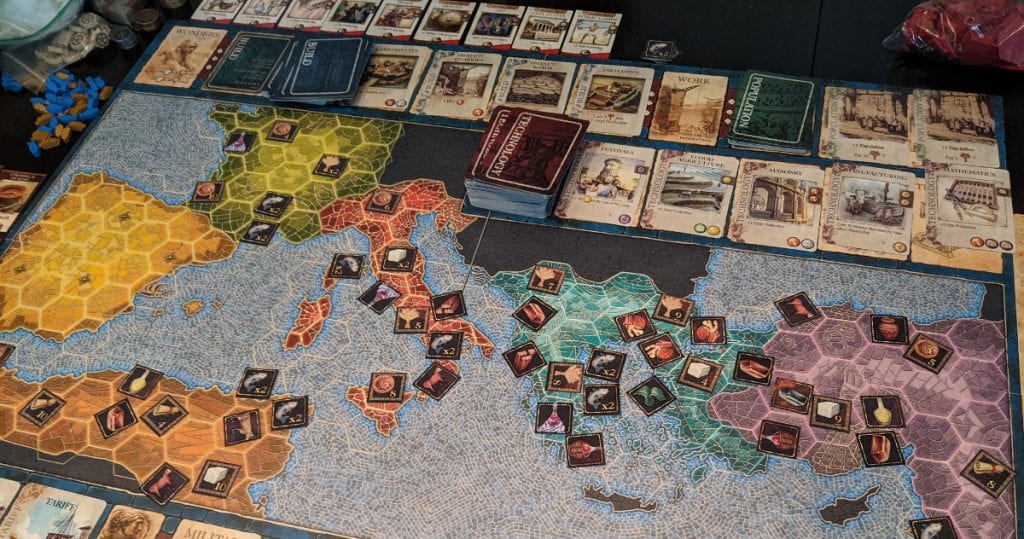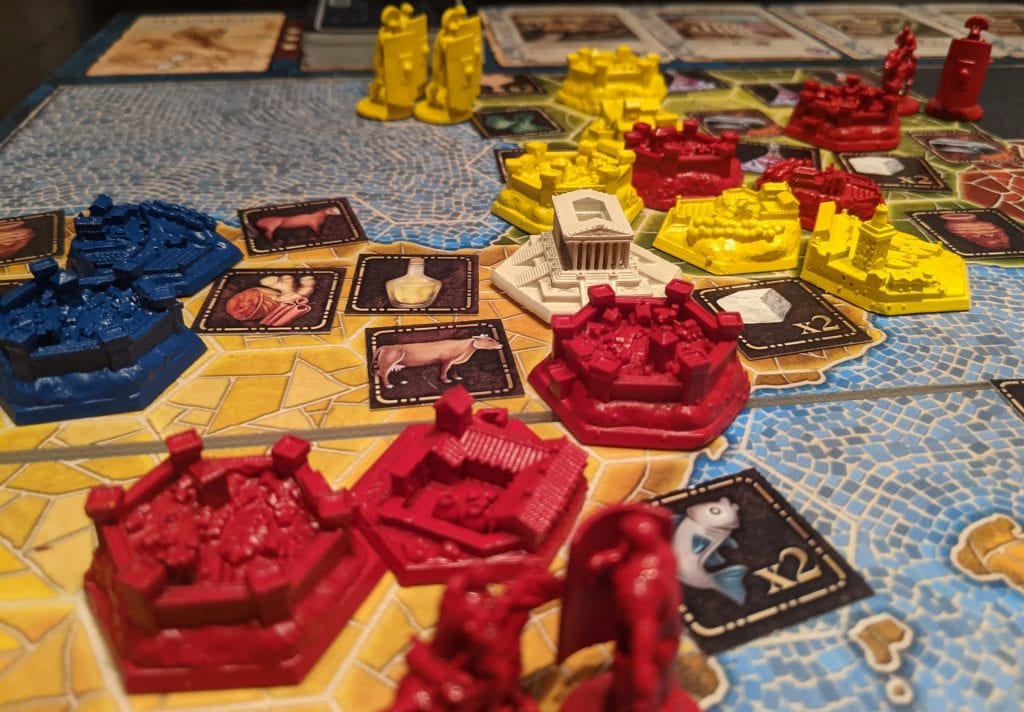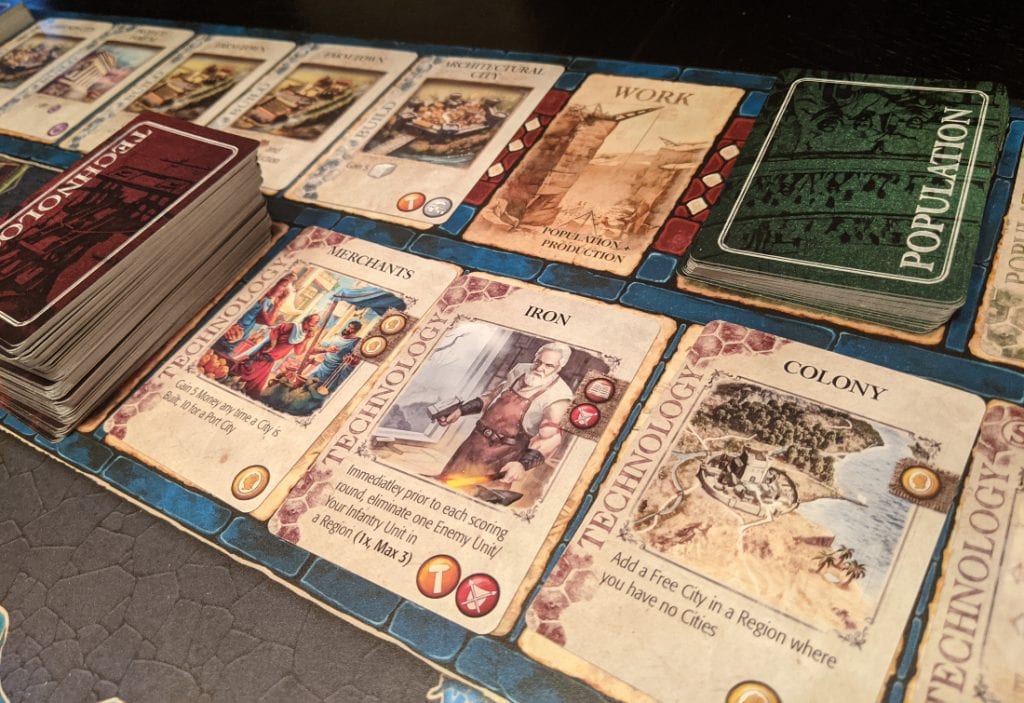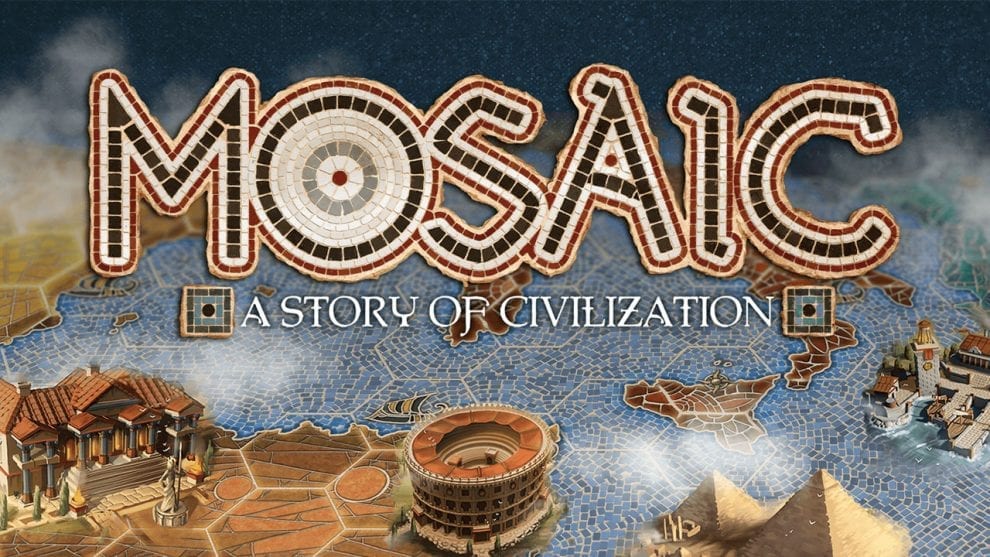Disclosure: Meeple Mountain received a free copy of this product in exchange for an honest, unbiased review. This review is not intended to be an endorsement.
Despite being into board games for well over a decade, I haven’t played a single game by Glenn Drover. I heard good things about Railways of the World and Age of Empires 3, but I’ve always understood that these games were long and semi-complicated from friends of mine who have played them.
With that type of reputation, my impressions of Mosaic surprised me. Despite the aesthetics of a typical civilization game, it’s not complex and doesn’t overstay its welcome. I feel Mosaic is Glenn Drover’s way of challenging the conventional wisdom of the genre as if he was doing a UFC-style callout and wouldn’t be happy until he knocked the poor bastard out in the first round.
But I am getting ahead of myself here. I need to give some context here.
Familiar Faces
A good place to start is the giant player mat in front of you, displaying the production for each resource type such as Taxes, Tariffs, Food, Ideas, and Stone. Besides production, you also have a supply area where you can hoard your resources to spend for various actions. If you have played Terraforming Mars, which is quite a few of you according to the numbers, then this setup should be very familiar.
You also start with a leader card with their own power, starting production and resources. Out of the list of 30 technology cards, you will draft five cards as your starting tech. This is perhaps one of my favorite starting features since the same leader doesn’t mean the same experience due to your starting tech.
The middle of the play area will have a board with the map and cards. The map contains distinct regions, filled with treasure tiles and trade goods. At the edges of the map are rows of face-up cards for you to purchase known as the Offer. There are four decks: Build, Population, Tax/Tariffs, and Technology.
Although there are cards in this game, the beating heart is the action selection, since you can only perform one action at a time. There are eight to pick from, and although that sounds like a high number, most of them are just trading resources for a card. Want a technology card? Spend five ideas. Growing your population? Hope you have food. If you want to build something, you will need some stone and population.

Planting The Seeds
The way cities are built is the first sign that this game doesn’t plan on following the conventional route. When you build a city, you can place it anywhere. There are no adjacent rules or settler units here. Are you in Rome and want to expand to the shores of Egypt for that sweet cow resource and positive Trip Advisor reviews? Be my guest.
While all of this sounds good, the added zest is the Build cards. If you build, you can take a matching offering card to get benefits. It can be something straightforward as gaining Stone resources in addition to your new city. Since these cards are only available for a limited time, and more than one person will probably want them, they present the challenge of action management and optimization that makes these games such an exciting challenge for me.
The Technology and Build cards also feature icons. They do nothing by themselves, but certain cards will reference them for effects. The more potent Technology cards have a prerequisite, meaning you can’t play the card until you have the required icons. Notice I said “play” and not buy. You can buy Technology cards even if you don’t plan on using any of them, as you place them face down and only will flip them once you reach the prerequisites. Spite drafters rejoice.
Owning Your Victory
The icons also serve one more purpose: Golden Ages. There are numerous ways to score points in this game, and one of them is grabbing a Golden Age card. Simply put, get six of one icon type before anyone else, and you earn six victory points and a bonus for nabbing the Golden Age card. It’s easier than writing this sentence.
To be clear, most of these cards give you resources or increase production. This is not a tableau or engine builder game with various funky abilities to mess around with. I’ll admit that while I do like my heavy dosage of card combos, I appreciate the change here. This is not to say that they aren’t game-changing cards, but they aren’t common. Like the ocean in the story of Moby Dick, the cards in this game provide a backdrop for a bigger picture. The white whale here is the action selection and the game will remind you of this.
A second way to earn points is through Achievements. Think of them as public objectives, such as controlling four regions or building five cities. Be the first to do an achievement, and you snatch it away from everyone else, spotlighting the importance of turn efficiency. Although it sounds very good, it can be overwhelming for new players because of the sheer number of them. My fingers are crossed here hoping for a player aid to highlight these Achievements in the final version.
Expanding The Tribe
Of course, to do those achievements, you will need a growing population. By spending food, you can acquire a Population card to pump those numbers up. Besides being a necessary factor in creating cities, Population improves your Work action. You can order your population to produce either Idea, Stone, or Food resources. A move like this isn’t exciting, but it can come in handy when you need resources urgently.
It will not be possible to lead your people properly without establishing a government. You can take one of the six available governments by spending resources. The different government types give you additional ways to score points or modify other actions, giving more ways to carve your identity in this alternative world while being mechanically engaging. They are quite different, so I will spare the details. Though I will admit it was entertaining to turn my drunk dancing Philosophies into a bronze hungry violent army and establish Tyranny in my first game.
As with most civilization games, this one also has Wonders, and you need resources to build them. These Wonders not only give you a treasure trove of victory points, but you place them physically in a region where you have a city, thus giving you more trading goods. However, like the Achievements, there are so many of them and now I’m using my other hand to cross my fingers in hopes for a player aid. Ever tried typing like this? It’s not easy.

Death And Taxes
There will be times where you don’t have the resources to get what you want, and that’s where the money comes in. You can use your coins as a substitute for a resource at a 2-for-1 ratio, but you need good old taxes and tariffs to get that precious metal. Both methods have different formulas for calculating your income. Taxes leverage the population numbers and icons, while Tariffs rely on the number of cities and unique trade goods. Either option will generate Unrest, which is negative victory points. Completely reasonable reaction.
Money can buy more than just resources; you can also purchase military units with them. Despite the appearance, there is no combat system in this game. All those hexes on the map are simply spaces for trade goods, cities, towns, and Wonders. When you build a military unit, you deploy it in a region, nothing more. You don’t even eliminate other military pieces unless you have a Technology card that allows you to do that. So what are they used for? Empire Scoring cards.
Each of the four decks contains an Empire Scoring card somewhere in the middle of each deck and revealing three of them will end the game. When one of these cards shows up, all the Regions on the map will score. Each City and Wonder gives 2 Influence, while each Military unit gives 1 Influence, plus any Technology cards effects.
If you have the highest influence in the region, you will score victory points based on the number of cities and Wonders in that region, even if they are not yours. While this may sound quite odd for using military units as passive-aggressive area control, it works. Whether you invest in cities with your stone supply or spending your excess gold on the military, it keeps everyone engaged while maintaining their virtual identity and idealogy.
Something New, Something Old
I am no stranger to civilization games in both electronic and board game forms. I played the original Civilization PC game during elementary school, and my high school years were a cocktail mix of Quake, Unreal, and Civilization. When I got into board games in the early 2000s, I tried many civilization games from the terrible to the later greats, such as Clash of Cultures and Through the Ages.
One of the things that I have observed over the years is the different methods designers use to curate the experience. Some designers want to create their games like a theme park, with the whole game designed to create a particular sort of play environment. Other games offer a canvas for you to do whatever you like within certain boundaries. Mosaic is one of the rare games where you get a palette to paint your experiences.
This viewpoint of mine was spurred by the scoring of regions. In Mosaic, your group’s collective decisions and investments determine the scoring potential of these regions. As a result, the value of these regions changes from game to game, giving you a sense of agency, and making each game uniquely yours.
Even the achievements give you this valley of choices to score points, and the only thing holding you back will be your incompetence since there are no catch-up mechanisms. Despite the lack of a combat system, the game is still quite competitive with players racing for objectives, winning regions, or drafting critical cards to rake in those beautiful points. In traditional civilization games, a conflict ends with swords, whereas Mosaic ends with pen strokes.

Opening The World
This open-ended experience continues with the various leaders’ powers. Usually, games involving asymmetrical powers often force players to play in a particular way or lose. Not the case in Mosaic. Every leader’s power gives you an edge in one area, yet gives you the ultimate decision on what role you play in this alternative universe. For example, as a Philosopher, you have Idea production and 2 free technology cards from the Offering at the start of the game. You have the technology edge, so do you want to focus on military tech? Population growth? The choices and the stories that go with them are yours to control.
Mosaic’s stories are not told through flavor text, but rather by its mechanisms if you are willing to listen. It aims to provide you with a streamlined experience while offering a buffet of options to explore. Even as I am writing this review, I am theory-crafting my future plays against my annoying friends. The game is tattooed to my brain.
While all of this sounds great, it is also intimidating during the first few playthroughs. The diversity of scoring options is astounding but provides very little guidance for newcomers. It’s only through repeated sessions that your brain will adjust and understand what is going on. Some players might not enjoy the journey to reach that level. The presentation further exacerbates the issue.
Size Does Matter
To illustrate my point, I didn’t build any Wonders in my first game. It wasn’t because of some grand strategy of mine. The Wonder tiles were on the other side of this giant board, and since I don’t have giraffe DNA, I couldn’t stretch my neck to see them. In a game where understanding the state of the situation is critical, having the presentation make it a challenge to gather information can hinder you from making proper decisions. Not exactly an ideal experience.
It is a bit table hog as well, stretching itself all over the place and calling attention to itself like it wants a belly rub. Even though I love its open-ended design and mechanisms, board games are a physical medium at the end of the day. If I have trouble putting it on my table, I’m less likely to play it as often as I like.
If table space or giant boards aren’t an issue for you, this one is a palatable treat. No, this isn’t a complicated version of Risk or a game with a big emphasis on war. Card synergy and Action selection take the place of the traditional wargaming elements found in “normal” civilization games. There is nothing in this design that feels out of place, and anyone who wants a distinct flavor of the civilization genre will find something to satisfy their tastebuds here.












Good review Very clear description of a game I’d like to enjoy more by doing better. I’ve had four plays with 3 and 4 player counts and finished last or nearly so each time. Getting the timing right for Empire Scoring rounds eludes me, not to mention missing out on Civilization Achievements or Golden Age Bonuses due to distraction and bedazzlement by all the perceived chaos on the board. I’m a sucker for Civ games though, so I’m sure this will continue to hit the (massive!) table as long as my gaming friends continue to enjoy their success at my expense😁!